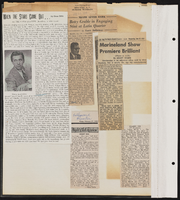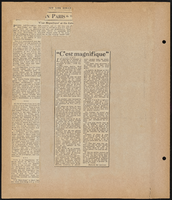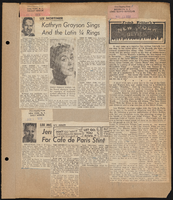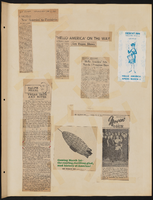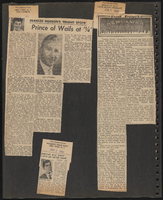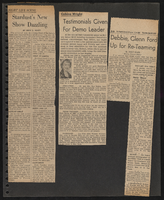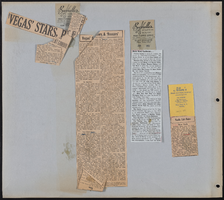Search the Special Collections and Archives Portal
Search Results
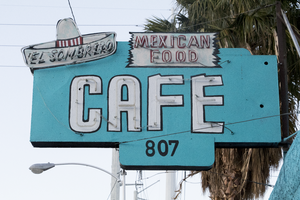
Photographs of El Sombrero Mexican Bistro sign, Las Vegas (Nev.), March 3, 2017
Date
Archival Collection
Description
Site address: 807 S Main St
Sign owner: Irma Aguirre
Sign details: This modest, family-owned restaurant has been in town since the 1950's. It was then sold to the current owner, Irma Aguirre, and closed for a brief moment for renovation in 2014. They have been serving favorites like burritos, enchiladas, taco, and tamales for six decades. Even with their modern updates, they are still staying as true to their past as they possibly can.
Sign condition: 5, the sign is still in beautiful condition.
Sign form: Hanging sign
Sign-specific description: The sign for the business extends out from the property towards the street. The rectangular sign is a bright blue that matches the color of the building. On the top outer corner of the sign sits a sombrero with a red and white striped band in the middle portion of the hat. The words "El Sombrero" are painted on the brim of the hat. There are skeletal neon tubes outline the hat and the words "El Sombrero." Next to this is a small sign, within the overall design of the rest of the sign, that is designed to look ripped on both sides and reads "Mexican Food" in red letters. Neon tubes outline these words. Underneath these elements of the sign is the word "CAFE" in bold white text with a thin black border. Neon tubes fill these letters as well. Extending from the bottom of the sign is a small rectangle with the building number "807" painted in black.
Sign - type of display: Neon
Sign - media: Steel
Sign environment: The area that this restaurant sits is right between the Arts District and the excitement of Fremont Street. The locations nearby is a bail bond store, a supply stores for gaming, lawn equipment, and discount appliances. It is also a short distance from the North Premium Outlets.
Sign - date of installation: Circa 1950's
Sign - date of redesign/move: Possibly 2014, they closed this year to renovate the building and the sign looks different today from earlier images of the sign. Before they renovated the building the sign included some sort of striped scarf/cloth underneath the sombrero. However, after the renovation this must have been painted over.
Sign - thematic influences: The sombrero on the sign also lends itself to the name of the property and the "Mexican Food" sign within the sign explicitly tells you what type of restaurant this is. It tells you the theme right away.
Sign - artistic significance: The sign itself is very simple, but the few specific design elements of the sign are very distinct to the property. The sombrero is a nice touch to emphasize the name of the restaurant and the "Mexican Food" sign is helpful in letting both motorists and pedestrians know what type of food they serve.
Survey - research locations: Las Vegas weekly article https://lasvegasweekly.com/dining/reviews/2014/nov/19/revamped-el-sombrero-cafe-mexican-downtown/ , Review Journal article https://www.reviewjournal.com/local/el-sombrero-a-mix-of-modern-classic/, asessor's page
Surveyor: Lauren Vaccaro
Survey - date completed: 2017-08-28
Sign keywords: Neon; Steel; Hanging; Cantilever construction
Mixed Content

Lindsay Wenger oral history interview: transcript
Date
Archival Collection
Description
Oral history interview with Lindsay Wenger conducted by Barbara Tabach on March 13, 2018 for the Remembering 1 October Oral History Project. In this interview, Lindsay Wenger discusses her move to Las Vegas, Nevada in 2013 for her residency at the University Medical Center of Southern Nevada (UMC). She talks about her experience on the night of the October 1, 2017 mass shooting and recalls a few specific patients she treated throughout the night and into the morning. After discussing the events at the hospital, she explains how she has been emotionally affected and how her view of Las Vegas as a community has changed.
Text

Olivia Meneses oral history interview: transcript
Date
Archival Collection
Description
Oral history interview with Olivia Meneses conducted by Elsa Lopez and Barbara Tabach on September 18, 2019 for the Latinx Voices of Southern Nevada Oral History Project. Olivia Meneses describes growing up in Mexico City and attending la Universidad Iberoamericana during the 1968 student movement that culminated in the Tlatelolco massacre. She discusses migrating to the United States in 1983 and moving to Las Vegas in 1985, where she began teaching Spanish to kindergarten students.
Text

